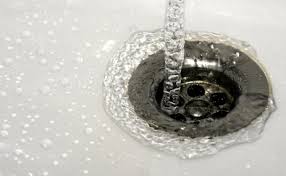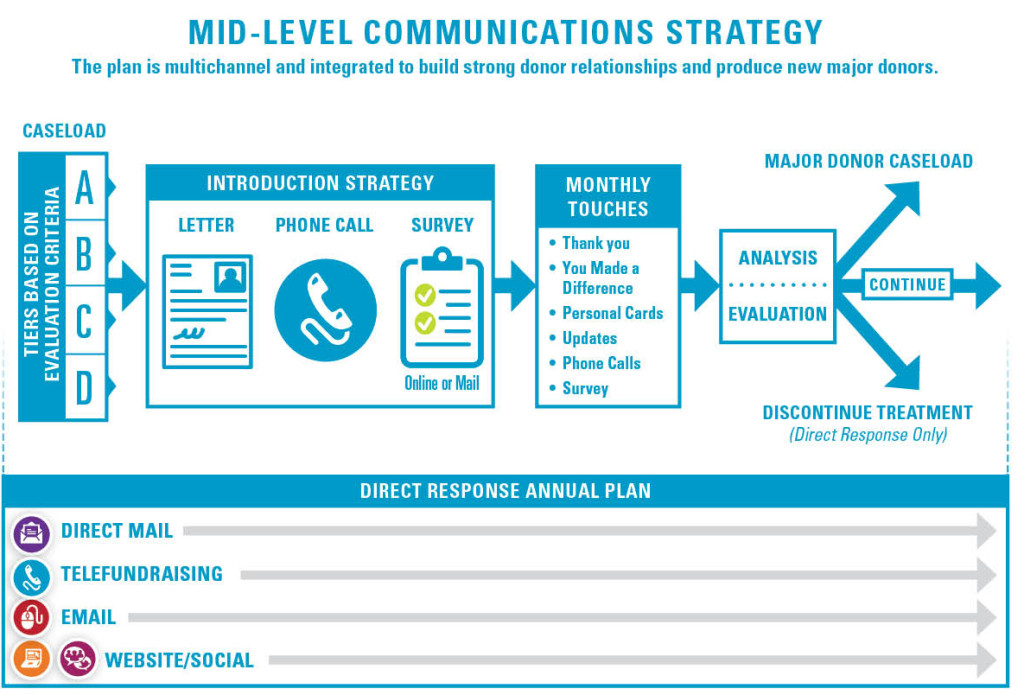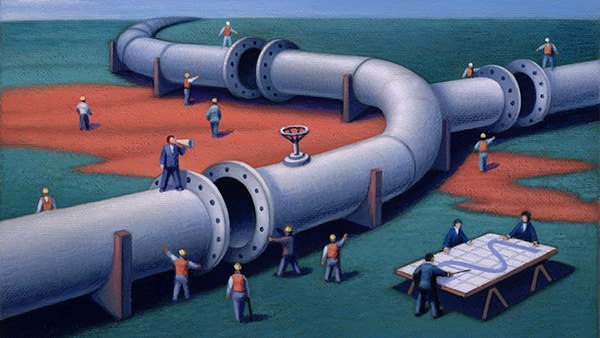
In my last post, I hope I convinced you WHY you should consider starting a mid-level donor program. Currently, nonprofit donor-base pipelines are clogged up with donors who are giving significantly; they are on their way to becoming major donors, but nonprofits are clumsily treating them like $15 donors.
You can change this! Here are the steps and the strategy to do it. NOTE: There is a lot here to digest, so I advise you to print this out and come back to it over and over again.
1. Start with the database — You want to determine who exactly your mid-level donors are. This can be done by 1) reviewing what you consider a major donor with your nonprofit, and 2) running queries on how many donors you have at certain yearly cumulative giving levels. For example, if you consider a major donor someone giving at the $10,000 cume level, then look at how many donors are in the $5,000-$9,999 level and the $1,000-4,999 levels. If you are a smaller organization, you may go down to the $250-$999 levels. This will give you a good idea of how many donors you might include in a mid-level program.
2. Determine the value of those donors – How much you can invest per donor in each of those cume giving levels? Look at the chart below:

You can create a similar chart to help you determine number of donors, revenue per donor and how much more you can spend per donor (in this scenario) based on a 10% lift in revenue. NOTE: you can create different revenue and return on investment (ROI) scenarios based on your budget.
To walk you through this, let’s look at the $500-$749 group of donors. The current revenue per donor is $442. Right now, most non-profits are spending between $10-$18 a donor to cultivate that donor. But if you create a mid-level program, from what we have seen with our clients, you could realize a 10% lift in revenue per donor in the program. In this case, that means you are going to bring in another $44 per donor. Depending on your tolerance for ROI, that means at a 2:1 ROI you could spend an added $22.10 on each donor. Or if you want to break even, you could spend up to $44 on each donor.
You might be asking, “why would I just want to break even on this program?” The answer: because you are now going to be moving more donors into a major gift program, those donors will be giving exponentially more – and it’s worth the break-even investment to get those donors into that program.
However, the beauty of this is that YOU get to determine the investment and return level you are seeking. At Veritus, Richard and I like to see three things happen with a mid-level program:
- KEEP – increase retention rates
- LIFT – create more value per donor (thus more NET revenue), and
- MOVE – move more donors into a major gift program at a faster rate than you would realize otherwise.
3. Create the Program – Just like a major gift program, we want to create a caseload of donors. However, in the mid-level program we’re going to start with 600 donors that are segmented into A-D levels, instead of the 150 donors that you would typically see in a major gift program caseload.
Then we’re going to create a 12-month communication strategy that includes an introductory series and monthly touches that thank the donor, report back on how their gifts made a difference and highlight donor milestones through e-mail, phone calls and personal notes. See the chart below to show you how this works visually:

As you can see here, underlying the mid-level program is all of your usual direct response work, or any annual fund plan that you typically run. Above that is the new mid-level program that runs concurrently with that plan.
4. Implement the Program – Ideally, just has you have a major gift officer working a caseload of 150 donors, you would have a mid-level gift officer who works a caseload of 600 donors. The mid-level gift officer would be charged with executing the plan.
However, you may not be able to hire a mid-level gift officer at this point. If that is the case, you can allocate a staff person and carve out whatever amount of time they can devote to it. That time will determine how large of a caseload they can handle. Remember that a full-time staff member can work 600 donors when working on nothing else, so use that as your guide.
5. Evaluate – We suggest that you evaluate the program after a year. The best and most accurate way to evaluate is to create an A/B split test when you begin this program. One panel of donors gets the mid-level treatment, and the other panel experiences no change from your previous treatment. Then determine if it’s successful. Once you determine its success, you’ll be making decisions on an ongoing basis about what donors should be moved into a major gift program, who will stay in mid-level and who will move down or back into the regular direct-mail stream.
Results
At Veritus we have been working with a number of clients both large and small, and we have some solid results of working a mid-level program for over 12 months. Here is what we are finding:
Client #1
After 12 months we realized a 10% lift in retention and revenue per donor over the control group. This equated to $3.4 million in increased revenue. Additionally, 68 donors graduated to a major gift program, compared to 10 in the control group.
Client #2
After 6 months we saw a 10% lift in revenue per donor and moved 364% more donors to major gifts than in the regular program.
Client #3
After 6 months we saw a 5% lift in revenue per donor, and the mid-level giving officer has helped shepherd 6 planned gifts.
Besides the hard data facts (science) we are seeing from mid-level programs, we are also hearing great stories (art). We are hearing how donors love being called to be thanked and to find out what they love about the organization. We are getting feedback on programs. We are hearing great donor stories about why they support the organization. And all of this is recorded in the donor database.
Starting a mid-level donor program is not necessarily easy. But nothing of merit ever is. Think about what an operation it was to get your annual fund or direct-response program going, or even launching your major gift program. It takes hard work and planning… but it can be done. And in our opinion, it should be done.
Keep that donor pipeline flowing. Chip away at whatever is causing it to be clogged, and you will see amazing things happening to your donor file.
Jeff
P.S. If you would like help starting and managing a mid-level donor program, Veritus Group would love to work with you and your organization. Click here, and I will contact you on how we can help. Thank you.







0 Comments